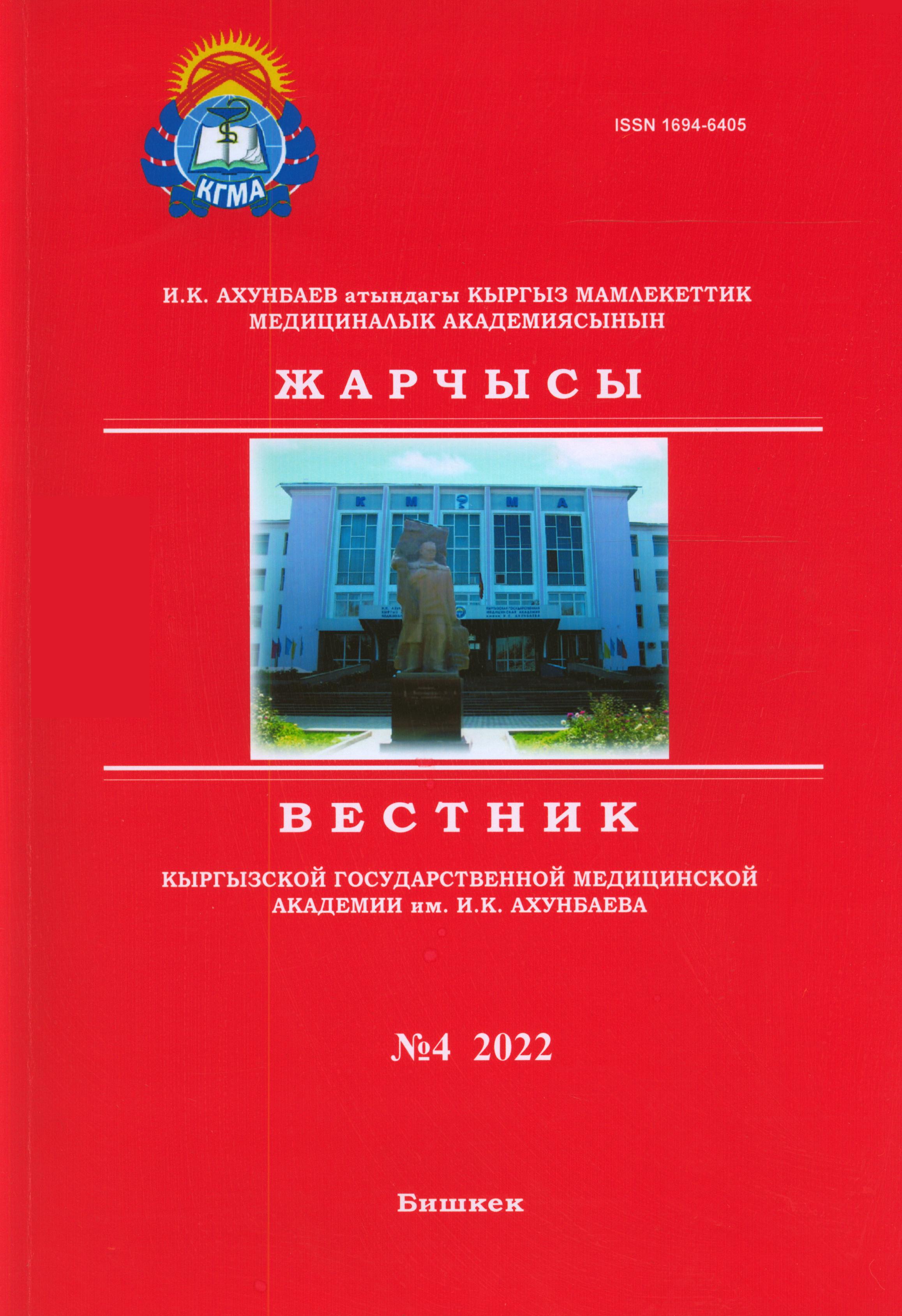DEVELOPMENT OF A METHOD FOR DISINFECTION OF SOIL FOCI
DOI:
https://doi.org/10.54890/1694-6405_2022_4_38Abstract
Summary. Disinfection and elimination of anthrax soil foci that interfere with the long-term development of the state is one of the urgent problems for many countries of the world. In the course of the work, experimental studies were carried out on the possibility of disinfection of the surface and deep layers of animal burial grounds using the method of drilling and moistening the soil with a solution. For the study, three experimental sites were prepared, measuring 1.0 x 1.0 m, on which the cultivated soil was naturally occurring of a gray-earth type. Each test site included 4 pits at a distance of 1.0 m, 80.0 cm and 50.0 cm from each other, respectively. After filling the wells and completely moistening the surface, a plastic film was additionally placed on top of each pad to prevent liquid evaporation. To control the moistening of the entire volume of soil for 3 days, control drilling of control wells was carried out daily at each experimental site: in the center between four pits; between two adjacent wells; and also away from the extreme pit at various distances. Experiments have shown that for complete tillage, i.e. for the entire depth of the soil hearth, the most optimal distance between the pits is 50 cm. At the same time, the volume of solution required to fill one well is from 35.0 to 38.0 liters of solution, with a hole diameter of 15 cm and a drilling depth of 3.0 m. In addition, for a complete one-time moistening of the surface of the treated area, the size of 1.0 x 1.0 m requires from 35.0 to 37.0 liters of solution. In general, for complete and high-quality humidification, it is necessary to fill each pit three times with an interval of 24 hours and also moisten the surface of the entire experimental site three times.
Keywords:
soil hearth, animal burial grounds, disinfection, pits, solution, anthrax.References
1. Лухнова Л.Ю., Ерубаев Т.К., Избанова У.А., Мека-Меченко Т.В., Сансызбаев Е.Б., Кирьянова Ю.С. и др. Сибирская язва в Восточно-Казахстанской области. Acta biomedica scientifica. 2019;4(5):127-134. [Luhnova LY, Erubaev TK, Izbanova UA, Meka-Mechenko TV, Sansyzbaev EB, Kir'yanova YS et al. Anthrax in the East Kazakhstan Region. Acta biomedica scientifica. 2019;4(5):127-134. (In Russ.).] https://doi.org/10.29413/ABS.2019-4.5.20
2. Лухнова Л.Ю., Избанова У.А., Мека-Меченко Т.В., Некрасова Л.Е., Атшабар Б.Б., Казаков В.С. и др. Сибирская язва в 2016 году в Казахстане. Медицина (Алматы). 2017;179(5):56-62. [Luhnova LY, Izbanova UA, Meka-Mechenko TV, Nekrasova LE, Atshabar BB, Kazakov VS et al. Sibirskaya yazva v 2016 godu v Kazahstane. Medicina (Almaty). 2017;179(5):56-62. (In Russ.).]
3. Лухнова Л.Ю., Избанова У.А., Мека-Меченко Т.В. Сибирская язва на территории Республики Казахстан в 1999-2020 годах, эпидемиологическая ситуация. Национальные приоритеты России. 2021;3(42):192-196. [Luhnova LY, Izbanova UA, Meka-Mechenko TV. Anthrax in the territory of the republic of Kazakhstan 1999-2020, epidemiological situation. Nacional'nye prioritety Rossii. 2021;3(42):192-196. (In Russ.).]
4. Маринин Л.И., Дятлов И.А., Шишкова Н.А., Герасимов В.Н. Сибиреязвенные скотомогильники: проблемы и решения. М.: Династия; 2017. 215 с. [Marinin LI, Dyatlov IA, Shishkova NA, Gerasimov VN. Sibireyazvennye skotomogil'niki: problemy i resheniya. M.: Dinastiya; 2017. 215 s. (In Russ.).]
5. Еременко Е.И., Рязанова А.Г., Буравцева Н.П. Современная ситуация по сибирской язве в России и мире. Основные тенденции и особенности. Проблемы особо опасных инфекций. 2017;1:65–71. [Eremenko E.I., Ryazanova A.G., Buravceva N.P. The Current Situation on Anthrax in Russia and in the World. Main Trends and Features. Problems of particularly dangerous infections. 2017;1:65–71. (In Russ.).] https://doi.org/10.21055/0370-1069-2017-1-65-71
6. Ямтитина М.Н., Макаров В.В. Экология сибирской язвы. Труды Федерального центра охраны здоровья животных. 2018;16:44-53. [Yamtitina MN, Makarov VV. Ecology of anthrax. Trudy Federal'nogo centra ohrany zdorov'ya zhivotnyh. 2018;16:44-53. (In Russ.).]
7. Султанов А.А., Горелов Ю.М., Сущих В.Ю. Почвенные очаги сибирской язвы. Порядок организации и проведения мероприятий по подготовке проб к исследованию (методические рекомендации). Алматы; 2015.53 с. [Sultanov AA, Gorelov YM, Sushchih VY. Pochvennye ochagi sibirskoj yazvy. Poryadok organizacii i provedeniya meropriyatij po podgotovke prob k issledovaniyu (metodicheskie rekomendacii). Almaty; 2015.53 s. (In Russ.).]
8. Картавая С.А. Оценка эпизоотолого-эпидемиологической опасности сибиреязвенных захоронений на территории РФ [автореферат]. М.; 2014.23 с. [Kartavaya SA. Ocenka epizootologo-epidemiologicheskoj opasnosti sibireyazvennyh zahoronenij na territorii RF [аvtoreferat]. M.; 2014. 23 s. (In Russ.).]
9. Поляков А.А. Ветеринарная дезинфекция. М.: Колос; 1975.254 c. [Polyakov AA. Veterinarnaya dezinfekciya. M.: Kolos; 1975.254 c. (In Russ.).]
10. Волконский Г.Д., Пилипенко В.Н., Попов В.Т. Опыт газовой дезинфекции сибиреязвенного скотомогильника в производственных условиях в Московской области. Труды ВИИИВС. 1979;63:34-39. [Volkonskij GD, Pilipenko VN, Popov VT. Opyt gazovoj dezinfekcii sibireyazvennogo skotomogil'nika v proizvodstvennyh usloviyah v Moskovskoj oblasti. Trudy VIIIVS.1979;63:34-39. (In Russ.).]
11. Соколова Н.Ф. Средства и способы обеззараживания воды (аналитический обзор). Медицинский алфавит. Эпидемиология и гигиена. 2013;(1):44-46. [Sokolova NF. Sredstva i sposoby obezzarazhivaniya vody (analiticheskij obzor). Medicinskij alfavit. Epidemiologiya i gigiena. 2013;(1):44-46. (In Russ.).]
12. Герасимов В.Н., Гайтрафимова А.Р., Дятлов И.А., Быстрова Е.В.; Заявитель и патентообладатель Федеральное бюджетное учреждение науки "Государственный научный центр по надзору в сфере защиты прав потребителей и благополучия человека (ФБУН ГНЦ ПМБ). Средство и способ обеззараживания участков почвы,контаминированных спорами сибирской язвы или бактериями возбудителей опасных и особо опасных инфекций. Российская Федерация Патент RU 2697723 C1. 06.08.2019. https://patenton.ru/patent/RU2697723C1.pdf [Gerasimov VN, Gajtrafimova AR, Dyatlov IA, Bystrova EV, inventors; Federal'noe byudzhetnoe uchrezhdenie nauki "Gosudarstvennyj nauchnyj centr po nadzoru v sfere zashchity prav potrebitelej i blagopoluchiya cheloveka (FBUN GNC PMB), assignee. Sredstvo i sposob obezzarazhivaniya uchastkov pochvy, kontaminirovannyh sporami sibirskoj yazvy ili bakteriyami vozbuditelej opasnyh i osobo opasnyh infekcij. Russian Federation Patent RU 2697723 C1. 2018 Aug 6. (In Russ.).]







